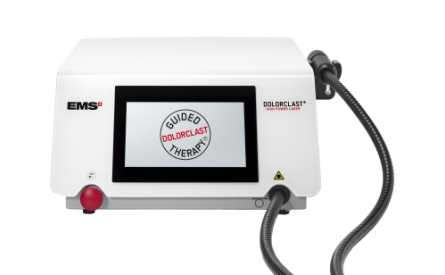A randomised, placebo controlled trial of low level laser therapy for activated Achilles tendinitis with microdialysis measurement of peritendinous prostaglandin E2 concentrations
Bjordal JM, Lopes-Martins RAB, Iversen VVA
British Journal of Sports Medicine 2006;40:76-80.
Randomised, placebo controlled study confirming that the right laser therapy can reduce pain by modulating inflammation.
Summary: Laser therapy can suppress an acute inflammation
The above mentioned research shows that exposing tissues to a specific laser light diminishes the acute inflammation thanks to the reduction of PGE2 as fast as 1 hour after the treatment. In this study, a low-level laser therapy was administered by a galium arsenide (GaAs) laser with an infrared wavelength of 904 nm with a laser probe consisting of three laser diodes placed longitudinally 9 mm apart.
In the laser group, a small decrease in Prostaglandin E2 concentration was seen first one hour after treatment, and then gradually decreasing from baseline (1.0) to 0.72 (95% CI 0.58 to 0.86) at the last time point 105 minutes after treatment. In comparison, Prostaglandin E2 concentrations were significantly reduced 75, 90, and 105 minutes after active LLLT compared with concentrations before treatment (p = 0.026) and after placebo LLLT (p = 0.009). In addtion, pressure pain threshold had increased significantly (p = 0.012) after active LLLT compared with placebo LLLT: the mean difference in the change between the groups was 0.40 kg/cm2 (95% confidence interval 0.10 to 0.70).
904nm wavelength leads to a reduction of the amount of Prostaglandin E2 (PGE2), which is a key marker of the inflammation. This effect is similar to how an NSAID would work, where the enzyme cyclooxegenase is being blocked and thus inhibts the Prostaglandin E2 production. WIth 904nm laser, the effect is likely caused by the switch-off effect of the nociceptors, which after a given time interval reduces the Prostaglandin E2 level. In other words, the laser is mimicking the effects of NSAIDs in a local way without the systemic side effects.
Conclusion: LLLT at a dose of 5.4 J per point can reduce inflammation and pain in activated Achilles tendinitis. LLLT may therefore have potential in the management of diseases with an inflammatory component.
Read more about how laser therapy is an essential part of the six step protocol that forms the Guided DolorClast® Therapy: Step 02: DolorClast® Laser


